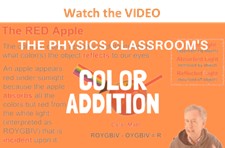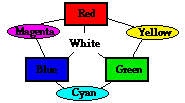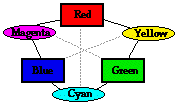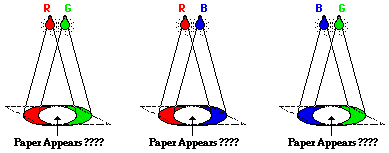Hold down the T key for 3 seconds to activate the audio accessibility mode, at which point you can click the K key to pause and resume audio. Useful for the Check Your Understanding and See Answers.
 Color perception, like sound perception, is a complex subject involving the disciplines of psychology, physiology, biology, chemistry and physics. When you look at an object and perceive a distinct color, you are not necessarily seeing a single frequency of light. Consider for instance that you are looking at a shirt and it appears purple to your eye. In such an instance, there may be several frequencies of light striking your eye with varying degrees of intensity. Yet your eye-brain system interprets the frequencies that strike your eye and the shirt is decoded by your brain as being purple.
Color perception, like sound perception, is a complex subject involving the disciplines of psychology, physiology, biology, chemistry and physics. When you look at an object and perceive a distinct color, you are not necessarily seeing a single frequency of light. Consider for instance that you are looking at a shirt and it appears purple to your eye. In such an instance, there may be several frequencies of light striking your eye with varying degrees of intensity. Yet your eye-brain system interprets the frequencies that strike your eye and the shirt is decoded by your brain as being purple.
Primary Colors of Light
The subject of color perception can be simplified if we think in terms of primary colors of light. We have already learned that white is not a color at all, but rather the presence of all the frequencies of visible light. When we speak of white light, we are referring to ROYGBIV - the presence of the entire spectrum of visible light. But combining the range of frequencies in the visible light spectrum is not the only means of producing white light. White light can also be produced by combining only three distinct frequencies of light, provided that they are widely separated on the visible light spectrum. Any three colors (or frequencies) of light that produce white light when combined with the correct intensity are called primary colors of light. There are a variety of sets of primary colors. The most common set of primary colors is red (R), green (G) and blue (B). When red, green and blue light are mixed or added together with the proper intensity, white (W) light is obtained. This is often represented by the equation below:
R + G + B = W
In fact, the mixing together (or addition) of two or three of these three primary colors of light with varying degrees of intensity can produce a wide range of other colors. For this reason, many television sets and computer monitors produce the range of colors on the monitor by the use of red, green and blue light-emitting phosphors.
The addition of the primary colors of light can be demonstrated using a light box. The light box illuminates a screen with the three primary colors - red (R), green (G) and blue (B). The lights are often the shape of circles. The result of adding two primary colors of light is easily seen by viewing the overlap of the two or more circles of primary light. The different combinations of colors produced by red, green and blue are shown in the graphic below. (CAUTION: Because of the way that different monitors and different web browsers render the colors on the computer monitor, there may be slight variations from the intended colors.)

Color Addition Rules
These demonstrations with the color box illustrate that red light and green light add together to produce yellow (Y) light. Red light and blue light add together to produce magenta (M) light. Green light and blue light add together to produce cyan (C) light. And finally, red light and green light and blue light add together to produce white light. This is sometimes demonstrated by the following color equations and graphic:
R + G = Y
R + B = M
G + B = C
|

|
Yellow (Y), magenta (M) and cyan (C) are sometimes referred to as secondary colors of light since they can be produced by the addition of equal intensities of two primary colors of light. The addition of these three primary colors of light with varying degrees of intensity will result in the countless other colors that we are familiar (or unfamiliar) with.
Investigate!
On this page we've discussed adding red, green and blue light in equal intensities. What happens if they are added in unequal intensities? For instance, suppose you are on the stage lighting team for your school's theatre. Your task is to control the red, green and blue stage lights to produce various color effects for the upcoming show. Use the Color Addition widget below to adjust the strength of the red, green and blue lights relative to full strength. A 1.00 indcates that the light is on at full strength; a 0.00 means the light is off. (All numbers should range from 0.00 to 1.00.) Once adjusted, click the Mix 'Em Up button to find out the result of mixing red, green, and blue components at various strengths.
Complementary Colors of Light
Any two colors of light that when mixed together in equal intensities produce white are said to be complementary colors of each other. The complementary color of red light is cyan light. This is reasonable since cyan light is equivalent to a combination of blue and green light; and blue and green light when added to red light will produce white light. Thus, red light and cyan light (which is equivalent to blue + green light) represent a pair of complementary colors of light; they add together to produce white light. This is illustrated in the equation below:
R + C = R + (B + G) = White
Each primary color of light has a secondary color of light as its complement. The three pairs of complementary colors are listed below. The graphic at the right is extremely helpful in identifying complementary colors. Complementary colors are always located directly across from each other on the graphic. Note that cyan is located across from red, magenta across from green, and yellow across from blue.
Complementary Colors of Light
Red and Cyan
Green and Magenta
Blue and Yellow
|

|
The production of various colors of light by the mixing of the three primary colors of light is known as color addition. The color addition principles discussed on this page can be used to make predictions of the colors that would result when different colored lights are mixed. In the next part of Lesson 2, we will learn how to use the principles of color addition to determine why different objects look specific colors when illuminated with various colors of light.
We Would Like to Suggest ...

Sometimes it isn't enough to just read about it. You have to interact with it! And that's exactly what you do when you use one of The Physics Classroom's Interactives. We would like to suggest that you combine the reading of this page with the use of our
RGB Color Addition Interactive. The Interactive is found in the Physics Interactives section of our website and allows a learner to adjust the intensity of red, green, and blue spotlights shining upon a white surface and to observe the appearance. Explore the result of mixing R, G, and B lights in equal and unequal intensities.
Check Your Understanding
1. Two lights are arranged above a white sheet of paper. When the lights are turned on they illuminate the entire sheet of paper (as seen in the diagram below). Each light bulb emits a primary color of light - red (R), green (G), and blue (B). Depending on which primary color of light is used, the paper will appear a different color. Express your understanding of color addition by determining the color that the sheet of paper will appear in the diagrams below.

2. Suppose that light from a magenta spotlight and light from a yellow spotlight are mixed together, will white light be produced? Explain.